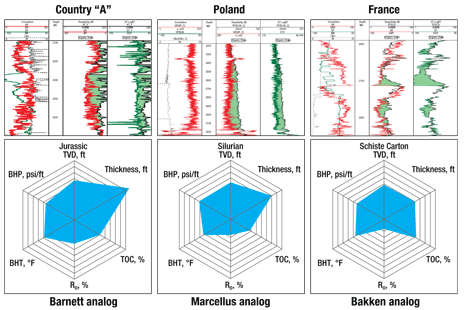SHALE ENERGY: Developing International Plays-The state of shale plays in Europe
The state of shale plays in Europe
Mike Mullen, Chief Operating Officer, Realm Energy International Let’s be honest. In 1981, how many people envisioned George Mitchell and Mitchell Energy as visionaries embarking on a new play concept? What about Lyco Energy as they pitched the concept of oil from the low-organic-maturity Bakken Shale being trapped in the tight Middle Bakken in 2000? Look at what has happened since these early explorers took a chance on an unconventional idea. Who would have thought that the source rock could also be the reservoir? They literally bet the company on finding a way to make these resource plays work.
Early in my career, I spent 12 years in the San Juan Basin of northwestern New Mexico and southwestern Colorado. The attitude among the operators there was a bit unconventional: Oil and gas were where you found it. They really didn’t stress over conventional reservoir analysis characteristics as much as they did producing hydrocarbons. Looking through historic production records, shale gas and oil (and even coal) completions can be found dating back to the mid-1950s. Most of this unconventional resource “exploration” was happening in one of the largest gas-producing basins in the US at that time. So the risk of chasing a gas show in a shale interval was rather small. There were usually other pay intervals to bail out the economics should it not be commercial. Turning to the shale plays of Europe, if we were to measure by the number of conferences discussing shale, we would have to conclude that a vibrant shale exploration industry was turning drill bits all over the continent. In reality, the state of shale plays in Europe is embryonic. Academic consortia are really just getting off the ground, as are industry-driven investigations. One of the key drivers is the desire by European governments to be more energy independent. As far as drilling goes, by my count there are two wells in Poland specifically drilled for a shale target. Additionally, PGNiG completed one well in a shale interval in Poland and a few wells in Germany targeting shale gas as well as tight gas. That’s about it. Most of the activity at this time throughout Europe has been in desktop exploration and land acquisition. At Realm Energy, our goal is to build a highly diversified portfolio of shale gas and oil plays throughout continental Europe. We began this effort by constructing snapshots of all the US shale plays consisting of their log characteristics, rock properties and geochemical characteristics. Then our geoscientists proceeded to examine 52 basins throughout continental Europe looking for similar characteristics for their shale gas and oil potential. While it is much easier to obtain data in North America, hard work and persistence obtaining the data that is available has directed our land acquisition efforts in Europe. The results suggest some very promising prospects (see figure). In the US, shale play exploration was driven by small to mid-sized operators until the plays were derisked, after which major oil and gas companies began entering the market. A similar pattern is shaping up in the early phases of exploration in many European countries. The difference is that the majors aren’t waiting as long to jump in the game. This is exemplified by ExxonMobil, Chevron, ConocoPhillips and Marathon, all of which have acquired sizable shale holdings in Europe. One challenge for shale exploration in Europe is the state of oilfield services: At this time, drilling, cementing and stimulation equipment is a bit limited there. It will not be just a simple matter of shipping equipment and personnel from the US. First, the high levels of equipment utilization of US equipment make it unprofitable to ship them to Europe. Second, it’s difficult to fit US-sized equipment on most European roads. So a little innovation will be required to fill this need. Luckily, oilfield engineers are an adaptive lot. So what is the state of shale gas in Europe? The best term I can think of to describe it is emerging. One can either stand on the sidelines and watch it happen or get in the middle of it and help make it happen. The next five to 10 years are going to be very exciting times in Europe. Only then will we know what European shale plays are really like and how they compare to their North American counterparts.
|
|||||||||
- Coiled tubing drilling’s role in the energy transition (March 2024)
- Shale technology: Bayesian variable pressure decline-curve analysis for shale gas wells (March 2024)
- Using data to create new completion efficiencies (February 2024)
- Digital tool kit enhances real-time decision-making to improve drilling efficiency and performance (February 2024)
- E&P outside the U.S. maintains a disciplined pace (February 2024)
- U.S. operators reduce activity as crude prices plunge (February 2024)
- Applying ultra-deep LWD resistivity technology successfully in a SAGD operation (May 2019)
- Adoption of wireless intelligent completions advances (May 2019)
- Majors double down as takeaway crunch eases (April 2019)
- What’s new in well logging and formation evaluation (April 2019)
- Qualification of a 20,000-psi subsea BOP: A collaborative approach (February 2019)
- ConocoPhillips’ Greg Leveille sees rapid trajectory of technical advancement continuing (February 2019)




